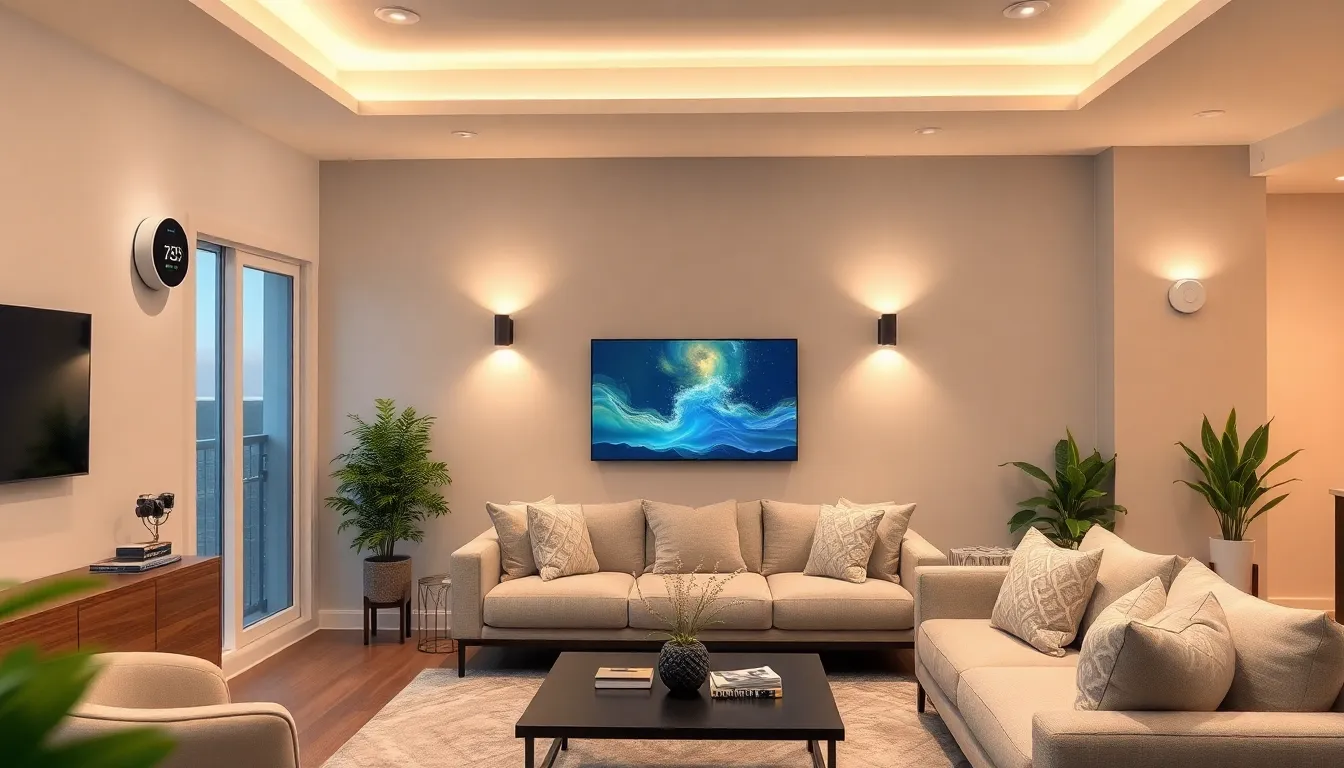In a world where the couch is the ultimate throne, remote home devices have become the royal court. Imagine controlling your lights, thermostat, and even your coffee maker without moving an inch. It’s like having a personal assistant who doesn’t judge your snack choices at midnight.
These devices aren’t just about convenience; they’re about transforming a house into a smart home. With the push of a button—or a voice command—you can create an ambiance that makes you feel like the star of your own reality show. Whether it’s setting the mood for a movie night or ensuring your home is safe while you’re away, remote home devices are the unsung heroes of modern living. Get ready to embrace the future of home automation that’s as easy as pie—because who doesn’t want a slice of that?
Table of Contents
ToggleOverview of Remote Home Devices
Remote home devices represent a significant advancement in home automation. Users gain the ability to manage lighting, temperature, security systems, and other essential functions through smart technology. Wireless connections facilitate these interactions, allowing seamless communication between devices and users.
Smart lighting systems offer customizable options for brightness and color, which enhances ambiance based on user preferences. Thermostats equipped with remote capabilities promote energy efficiency by learning user schedules. Such equipment adjusts temperatures automatically, leading to reduced energy consumption and lower bills.
Security systems incorporate cameras and sensors, crucial for monitoring homes. Alerts provide real-time notifications about unusual activities. Many systems support remote access, enabling users to check feeds or arm alarms from anywhere using mobile applications.
Smart speakers serve as hubs, coordinating various devices. Voice commands enable hands-free operation, simplifying the management of multiple functions. Owners can easily interact with devices, making routines more efficient.
According to market research, the global smart home market is projected to reach $135.3 billion by 2025, emphasizing the growing trend toward automation. Increasing adoption of Internet of Things (IoT) technology connects diverse devices, enhancing the interconnectedness of home environments.
Remote home devices enhance comfort, security, and efficiency, shaping the future of residential living. They empower users, transforming traditional homes into smart spaces that adapt to lifestyles. The overall trend continues toward greater innovation and integration within the realm of home automation.
Benefits of Remote Home Devices

Remote home devices provide users with an array of benefits that significantly enhance their living experience.
Convenience and Efficiency
Convenience defines the use of remote home devices. Users can control heating, lighting, and appliances from anywhere in their homes using smartphones or smart assistants. This capability eliminates the need for manual adjustments, making daily routines more efficient. Smart lighting options allow individuals to customize settings for various activities, such as reading or entertaining. Thermostats can learn user schedules, optimizing energy use without requiring constant input. Various sensors detect changes, enabling automation for added ease. Overall, these technologies save time and streamline household management.
Enhanced Security Features
Enhanced security features represent another key benefit of remote home devices. Smart security systems include cameras and motion detectors that provide real-time monitoring. Notifications alert users to unusual activity, enabling proactive responses. Remote access ensures that individuals can check security feeds or adjust settings even when away from home. Many systems support integration with other devices, such as smart locks, allowing for seamless control. This interconnected nature increases overall safety and peace of mind. Adoption of remote security devices is pivotal for those prioritizing home protection.
Popular Types of Remote Home Devices
Remote home devices come in various forms, enhancing user experience and automation. Each type provides unique functionalities that contribute to a smarter living environment.
Smart Thermostats
Smart thermostats allow users to regulate temperature with ease. These devices learn user preferences, adjusting settings automatically based on schedules and occupancy. For instance, Energy Star estimates that homeowners can save about $180 annually by utilizing smart thermostats. Remote access through mobile apps provides control from anywhere, ensuring comfort upon arrival. Many models integrate with other smart devices for enhanced efficiency and customization, fostering an eco-friendly lifestyle.
Smart Lighting Systems
Smart lighting systems offer remarkable convenience and energy savings. Users can control brightness and color through smartphone apps or voice commands. These systems enable automation, such as dimming lights during movie nights or brightening during morning routines. Notably, customizable settings align with various activities or moods, promoting ambiance. According to research, smart lighting can reduce energy consumption by up to 80%, making these systems not only versatile but also cost-effective.
Security Cameras and Alarms
Security cameras and alarms provide essential monitoring and protection for homes. Users receive real-time alerts for suspicious activities via mobile notifications. Many models include features like two-way audio and night vision, enhancing overall security. Research indicates that homes with security systems experience 300% less burglary risk. In addition, integration with smart home hubs allows for coordinated responses, further improving home safety and peace of mind.
Considerations Before Buying
Prior to purchasing remote home devices, examining a few critical factors ensures the selection of the right products for individual needs.
Compatibility with Existing Systems
Assessing compatibility with existing systems plays a crucial role. Many remote home devices integrate seamlessly with popular smart home ecosystems such as Amazon Alexa, Google Assistant, and Apple HomeKit. Before committing, verifying that the chosen devices work well with current setups avoids potential frustrations in the future. Considering wireless protocols like Wi-Fi, Zigbee, or Z-Wave also enhances the chances of smooth connectivity. Incompatible devices hamper smart home functionality, negating the benefits that prompt homeowners to invest in these technologies.
Privacy and Security Concerns
Privacy and security concerns arise with the increasing number of connected devices. Many remote home devices collect personal data, which raises questions about its protection. Prioritizing devices with strong encryption and data privacy measures mitigates risks. Consumers should investigate the manufacturer’s privacy policies and terms of service before making decisions. Regular software updates can enhance device security and protect home networks from potential threats. Implementing strong, unique passwords for devices further safeguards against unauthorized access, providing peace of mind when managing home automation systems.
Remote home devices represent a significant leap forward in home automation and convenience. They not only simplify everyday tasks but also enhance security and energy efficiency. As technology continues to evolve the integration of these devices will likely become even more seamless and intuitive.
Adopting remote home devices can transform a traditional living space into a smart home tailored to individual lifestyles. With the growing market and ongoing innovations users can expect even more features that cater to their needs. Embracing this technology can lead to a more comfortable secure and efficient home environment.




